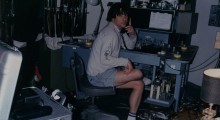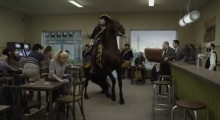6576 Results for “production”
-
Chronicle of a Dream Foretold: BAMcinemaFest 2015

“Withdrawing in disgust is not the same as apathy,” comments one of the tenuously overlapping characters in Richard Linklater’s 1991 game-changer Slacker. The word itself, fairly recent at the time of production, is a moniker the speaker fully embraces. The branding may sound tactless, if not downright pejorative, but it’s not at all: It implies enough empathy and humanity to seek out options to offset destructive disinterest in matters tangible, ethical, or both. In the creative sphere, the shift in course can lead to an untried M.O. and the models it might generate — if the stars are properly aligned, […]
by Howard Feinstein on Jun 16, 2015 -
“You Can’t Turn Around Without Bumping into a Zombie Movie”: Joe Dante on Burying the Ex

With Burying the Ex (opening theatrically and on VOD June 19), one of the greatest directors of the past forty years returns to the style that made him famous while also striking out in immensely entertaining new directions. Joe Dante’s first film, the Roger Corman-financed Hollywood Boulevard (co-directed with Allan Arkush), established him as a singular satirical voice; like many of the films that would follow (The Howling, Gremlins and Gremlins 2, Matinee, etc.), it was both a celebration of and a sly commentary on American pop culture, with a delirious wit and energy masking an underlying seriousness. Over the […]
by Jim Hemphill on Jun 16, 2015 -
Sundance Institute Announces Eight Projects for Documentary Edit and Story Labs

The Sundance Institute has announced the eight projects that will take part in their Documentary Edit and Story lab at the Sundance Resort in June and July. All participating projects are in the advanced stages of post-production and will work on their rough cuts in the two-part lab. This year’s Creative Advisors include Marshall Curry (Point and Shoot), Geoffrey Richman (Racing Extinction), Kate Amend (The Case Against 8), Richard Hankin (God Loves Uganda), Victor Livingston (The Queen of Versailles) and more. The full list of projects and synopses is below. The Bad Kids Director: Keith Fulton & Lou Pepe Editor: Jacob Bricca At […]
by Sarah Salovaara on Jun 15, 2015 -
Understanding Copyright Law: Pitches, Facts, Characters and the Ambiguities of Section 102

Gregory Bernstein’s book Understanding the Business of Entertainment, the Legal and Business Essentials All Filmmakers Should Know, published this week, discusses such important topics for filmmakers as copyright law, First Amendment law, the FCC, the growth of media conglomerates, studio development and distribution, entertainment contracts, as well as a section for independent filmmakers. The following excerpt comes from the chapter about copyright law. Among many other things, the chapter discusses how story ideas cannot be copyrighted. The excerpt below, however, discusses one way filmmakers and other creative people can nevertheless protect ideas from being stolen, and whether facts, characters and titles may be copyrighted. Protecting Ideas via Contract Law Say […]
by Gregory Bernstein on Jun 10, 2015 -
“I’m Very Aware That in the Movies I Love There is No One Who Looks Like Me”: Lauren Domino on Producing in New Orleans

When Miles Davis moved to the Upper West Side in 1958, backyard jams with visiting musicians transformed the small block. His residency lasted about 25 years, so he was long gone by the time I moved in to the building next door. But I was there for the block party last year when the street was renamed in his honor. In spite of the loudspeaker recordings, I got to hear the street on jazz. And immersed in the throngs of his friends and relatives, I felt transported. The next day, walking past a new 24hr CVS on the nearby corner, […]
by Taylor Hess on Jun 9, 2015 -
Mad Women: An Excerpt from Jeff Lipsky’s Memoir

Filmmaker Jeff Lipsky’s latest feature, Mad Women, opens July 10th in New York, July 24 in Los Angeles and across the country in August. Here, the longtime distributor and director shares an excerpt from his upcoming memoir, which is scheduled for publication in 2016. At noon, on an early October day in 2014, after wrapping a scene at the Plainview Library for my sixth film Mad Women, a scene that would end up on the editing room’s digital floor, I commandeered a crew car and chaffeured a breakaway team to race back to Massapequa, Long Island. I needed to film […]
by Jeff Lipsky on Jun 9, 2015 -
Not “Making Bad Movies with State Money”: Roy Andersson on A Pigeon Sat on a Branch Reflecting on Existence

I used to dismiss the films of Roy Andersson for their coldness and repetition; a mistake. While the Swedish filmmaker’s camera hangs at an ever-stiffer remove, each scene he shoots is suffused with minute power dynamics, rendering the players — aimlessly shuffling to and fro, outfitted in sepulchral pancake makeup — both tragically pathetic and pathetically hilarious. A Pigeon Sat On A Branch Contemplating Existence, the 73-year-old auteur’s latest, caps Andersson’s so-called “human existence trilogy” with a surprising rumination on repressed cultural memory stitched within the director’s signature vistas of human cruelty. Andersson has been perfecting this droll, widescreen aesthetic […]
by Steve Macfarlane on Jun 5, 2015 -
“You Just Keep Bad Things Away from Your Project — That’s What a Director Does”: Katerina Cizek on the She Does Podcast

Katerina Cizek is an innovative documentary storyteller who works across many media platforms. She’s currently the director of the National Film Board of Canada’s multi-year project entitled HIGHRISE, which examines life inside residential skyscrapers in suburbs around the world. Since it launched in 2009, HIGHRISE has generated interactive documentaries, mobile productions, live presentations, installations and films that have garnered Emmys, a Peabody, Webby Awards and recognition from the World Press Photo and IDFA Doc Lab, among others. On June 2, 2015, Kat and the NFB released the latest and final HIGHRISE project, “Universe Within,” that explores people’s digital lives online. […]
by Elaine Sheldon and Sarah Ginsburg on Jun 3, 2015 -
Cooed: A Pigeon Sat on a Branch Reflecting on Existence

Powerful imagination and credible spatiality are among the major absences in today’s cinema lamented by Swedish filmmaker Roy Andersson. A compensatory corrective is provided, of course, by his own films, including multiple award-winning commercials and the films in “The Living Trilogy”: Songs From the Second Floor (2000), You the Living (2007), and, just opening in the US, the marvelously wry A Pigeon Sat on a Branch Reflecting on Existence (2014). The movies are assemblages of broad tableaus of relatively short duration, filmed with a static camera. The segments are like an inspired mix of tromp l’oeil, flattened Joseph Cornell boxes, and Gregory […]
by Howard Feinstein on Jun 2, 2015 -
40 Locations in 18 Shooting Days: Lessons Learned While Making Doomsdays

Nobody ever comes out of a movie and says “great locations!” Unless the film is set someplace unusual like the Amazon or the UN or on an elaborately constructed set that makes locations a talking point, they’re largely taken for granted. But locations are nevertheless deeply felt by audiences whether they announce themselves or not, informing mood, camerawork, production design and performance. They’re also a cheap way to make an inexpensive film stand out, or at the very least make it look more expensive than it is. Among the oft-repeated cardinal rules of low-/no-budge filmmaking, there are two that apply […]
by Eddie Mullins on Jun 1, 2015










